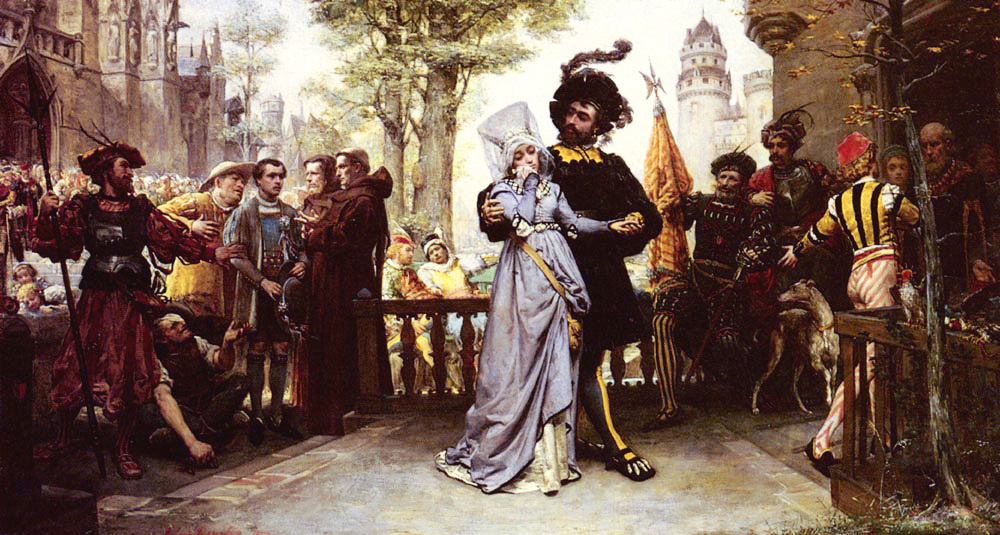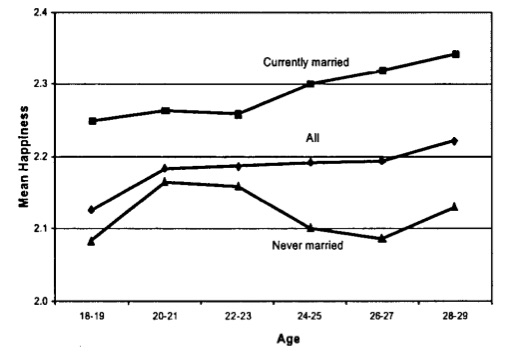Jules Arsene Gardie, Le Droit Du Seigneur 1872
Mazal Tov; When's The Wedding?
Today, when a bride and groom wish to secure a wedding day, it will depend on their budget and the availability of the caterer. My, how things have changed. In the times of the Mishnah, the wedding day was decided by the availability of the local rabbinic court, the Bet Din. Then, a wedding (of a virgin) could only take place on the night before the Bet Din convened. This would ensure that if, after their magical first night, the groom suspected that his bride had not been a virgin, he could take his claim to court the very next day.
“ מפני מה אמרו בתולה נשאת ליום הרביעי שאם היה לו טענת בתולים היה משכים לב”ד
Why did they teach that a virgin must only marry on a Wednesday? So that if the groom questioned her virginity, he could hurry to the Bet Din...”
Today's page of Talmud explains that this happy custom changed during a period of persecution. Rabbah, a fourth century Babylonian sage, explained what this is all about:
אָמַר רַבָּה, דְּאָמְרִי: בְּתוּלָה הַנִּשֵּׂאת בְּיוֹם הָרְבִיעִי תִּיבָּעֵל לַהֶגְמוֹן תְּחִלָּה
"[The authorities] said, "a virgin who gets married on Wednesday will first have intercourse with the governor" (הגמון). In order to avoid this awful legal rape, the wedding was moved a day early, to fly, so to speak, under the radar of the local governor. The Talmud also explains that this edict only applied for those who married on a Wednesday, rather than any other day of the week, which is an odd detail that is difficult to explain.
A longer version of the legend is found in the Jerusalem Talmud (Ketuvot1:5). Here it is.
בָּרִלאשׁוֹנָה גָֽזְרוּ שְׁמָד בִּיהוּדָה. שֶׁכֵּן מְסוֹרֶת לָהֶם מֵאֲבוֹתָם שֶׁיְּהוּדָה הָרַג אֶת עֵשָׂיו. דִּכְתִיב יָֽדְךָ בְּעוֹרֶף אוֹיְבֶיךָ. וְהָיוּ הוֹלְכִין וּמְשַׁעְבְּדִין בָּהֶן וְאוֹנְסִין אֶת בְּנוֹתֵיהֶן וְגָֽזְרוּ שֶׁיְּהֵא אִיסְטְרָטֵיוֹס בּוֹעֵל תְּחִילָּה. הִתְקִינוּ שֶׁיְּהֵא בַּעֲלָהּ בָּא עָלֶיהָ עוֹדָהּ בְּבֵית אָבִיהָ. שֶׁמִּתּוֹךְ שֶׁהִיא יוֹדַעַת שֶׁאֵימַת בַּעֲלָהּ עָלֶיהָ עוֹד הִיא נִגְרֶרֶת
In earlier times they [the Romans] decided on a persecution in Judea because they had a tradition from their forefathers that Jehudah had killed Esav, as it is written Gen. 49:8: “Your hand is on your enemies’ neck.” They went and enslaved the Jews and raped their daughters; and they decided that a soldier would cohabit with a bride first. The Sages decreed therefore that her husband should cohabit with her while she was still in her father’s house, for when she knows that her husband’s fear is on her she is drawn after him…
This episode likely describes the period after the Bar Kochba rebellion, and as the Guggenheimer translation notes, the Bavli is a “toned down” version of the this story. In this version, any soldier could take the bride, and not just the hegemon, and he could claim the bride on any day, not just on a Wednesday.
Jus Primae Noctis in the Talmud & Midrash
The law that Rabbah referenced is known variously as Jus Primae Noctis, the Law of the First Night and, much more graphically, as The Right to the Thigh - Droit du Cuissage. Its origins are further explained in the Talmud Yerushalmi, which dates it to the time of the Bar Kochba revolution:
תלמוד ירושלמי כתובות פרק א הלכה ה
בראשונה גזרו שמד ביהודה שכן מסורת להם מאבותם שיהודה הרג את עשו... והיו הולכין ומשעבדין בהן ואונסין את בנותיהן וגזרו שיהא איסטרטיוס בועל תחילה התקינו שיהא בעלה בא עליה עודה בבית אביה
In the beginning, they [the Romans] decreed destruction in Judea (for they had a tradition that Yehuda killed Esau) ... and they enslaved them and raped their daughters, and decreed that a soldier would have intercourse [with a bride] first. It was then enacted that her husband would cohabit with her while she was still in her father's house.
A reference to Primae Noctis also appears in the Midrash Rabbah, a collection of rabbinic homilies edited sometime in the forth or fifth century. As told in Genesis 6, “the sons of God saw that the daughters of man were beautiful (tovot), and they took wives from whoever they chose.” The Midrash focuses on that word beautiful, and explains:
בראשית רבה (וילנא) פרשת בראשית פרשה כו
אמר רבי יודן טבת כתיב, משהיו מטיבין אשה לבעלה היה גדול נכנס ובועלה תחלה, הדא הוא דכתיב כי טבת הנה, אלו הבתולות ויקחו להם נשים מכל אשר בחרו, אלו נשי אנשים,
“Rabbi Judan said the word tovot (טבת) – beautiful – is written in the singular, [but read as a plural]. Meaning that the bride was made beautiful for her husband, but the lord of the nobles had intercourse with her first...”
This midrash is cited by Rashi (d. 1105), the great French exegete, in his commentary to the Torah. And this isn't the only time Rashi uses Primae Noctis to explain a historical event. According to Rashi, it was this law that precipitated the rebellion of the Maccabees against their Greek oppressors, an uprising that culminated in the miracle of Chanukah:
תלמוד בבלי שבת דף כג עמוד א
דאמר רבי יהושע בן לוי: נשים חייבות בנר חנוכה, שאף הן היו באותו הנס
רש"י שם: שגזרו יוונים על כל בתולות הנשואות להיבעל לטפסר תחלה
Rabbi Yehoshua ben Levi said: Women are obligated to take part in the lighting, for they were included in that miracle...
Rashi: For the Greeks made an edict that all virgins who were about to marry must first have intercourse with the Prefect...
JUS PRIMAE NOCTIS...IN THE Movies
There are numerous references to Primae Noctis in ancient and modern literature, from the Epic of Gilgamesh to The Marriage of Figaro. One more recent example can be seen in the 1995 movie Braveheart, when the evil King Edward gallops into a village, to interrupt a wedding celebration. “I’ve come to claim the right of Primae Noctis. As lord of these lands, I will bless this marriage by taking the bride into my bed on the first night of her union.” And as the groom is restrained by Edward's henchmen, Edward reminds the peasants “it is my noble right.”
Jus Primae Noctis. Is there a more fearsome example of feudal barbarism? Of what one scholar called “a male power display…coercive sexual dominance…and male desire for sexual variety”? But the legend, despite its appearance in many guises, is, fortunately, likely to be nothing more than just that: a legend.
Jus Primae Noctis...is a Legend
Perhaps the most comprehensive investigation of the legend of Primae Noctis is The Lord's First Night: the Myth of the Droit de Cuissage, by the French social scientist Alain Boureau. (I bought my copy for less than $10, and no, you can't borrow it.) His careful analysis is particularly important since, as we have seen, Rashi, our favorite French commentator, cites this legend twice. After a meticulous two-hundred page review of every alleged appearance of the legend, Boureau is clear:
““[T]he droit de cuissage never existed in medieval France. Not one of the arguments, none of the events insinuated, alleged or brandished, holds up under analysis.””
Others scholars agree with Boureau. In 1881, the German historian Karl Schmidt concluded that the right never existed. In 1973, the historian J.Q.C. Mackrell noted that there is "no reliable evidence" that it existed. And Prof. Tal Ilan, of the Free University of Berlin, addressed the myth of Primae Noctis in a magnificently titled 1993 paper: Premarital Cohabitation in Ancient Judea. Prof. Ilan noted that that “all medieval literature that evokes the custom of Jus Primae Noctis has been proven to be folkloristic and has no historical basis.” But what about the evidence from the Talmuds, and the Midrashim? Don’t they provide evidence that Primae Noctis was indeed practiced in the time of the Talmud? Not so, claims the professor:
“If a motif of this sort could have appeared in a sixteenth-century document and upset the entire history of medieval Europe for the next two centuries, the same motif likewise could have cropped up in the fourth -or fifth-century Palestinian Talmud, falsely describing events of the second century.”
Instead, Prof Ilan suggests that the Talmud used the myth of Primae Noctis to excuse the behavior of some prospective couples, who would engage in sexual relations before they married. “the jus primae noctis was conveniently drawn in order to explain and justify a custom that seemed to the rabbis to undermine their view of proper conduct in Jewish society.”
“Some events do take place but are not true; others are—although they never occurred.’
”
There is some further support to the claim that primae noctis never existed, and it is not one I have seen suggested before. It is a claim from silence. I've checked over 100,000 responsa, and there is not one on this topic. Not a single one. If primae noctis really was a law of the Greek and Roman empires, and a feudal right across medieval Europe, then why were its implications for the Jewish community never discussed in the responsa literature? This silence supports the conclusions of work done by Boureau, Ilan and others: it never existed. In fact Boureau wonders what muddled thinking would lead anyone to believe it existed in the first place:
It has been clear from the start that no matter what social restrictions were put on conduct and the management of wealth, and no matter how violent mores became, the principle of free choice of an unfettered matrimonial life was the most sacred area of individual liberty in medieval Europe. The Church, European society's principal normative center, very early removed all restrictions on the marriage of dependents, and it imposed consent as a sacramental value. No juridicial form, no custom, could attack that principal...sanctified in the twelfth century by the establishment of the sacrament of matrimony.
History and Heritage
The historian David Lowenthal has explained the differences between history and heritage. While history "seeks to convince by truth," heritage "passes on exclusive myths of origin and endurance, endowing us alone with prestige and purpose." Heritage, continues Lowenthal, commonly alters the past: sometimes it selectively forgets past evils, and sometimes it updates the past to fit in with our modern sensibilities. Sometimes it upgrades the past, making it better than it was, and sometimes it downgrades the past, to attract sympathy. And so, how we read the Talmud will depend on whether we see it as a work of history or as a book of our heritage.
“There you have it...some of it fact, and some of it fiction, but all of it true, in the true meaning of the word”
There are stories both wonderful and terrible from our Jewish past. Some are factual, and some are not, and a measured approach to how we might approach these stories has been suggested by Judith Baumel and Jacob J. Schacter. They explored the claim (published in The New York Times) that in 1942, ninety-three Beis Yaakov schoolgirls in Cracow committed suicide rather than face rape by their German captors. They concluded that the evidence to support the truth of the story is not conclusive one way or the other.
Whether or not it actually happened as described is difficult to determine, but there is certainly no question that it could have happened...in response to those claiming that the incident was "unlikely" to have occurred, let us remind the reader that the period in question was one during which the most unlikely events did occur, when entire communities were wiped out without leaving a single survivor...Maybe it did happen. But maybe again it didn't. Could it have happened? Of course.
The horrors of the Holocaust left in their wake a hope that, having touched the lowest levels of depravity, humanity would say Never Again, and a new era of responsibility for all of would follow. But our recent history shows that this lesson was not learned, that the world can be a truly terrible place. The legend of Primae Noctis is not likely to have been true. But some stories are true, even though they never happened. Ask yourself, from what you know about Jewish history, could it have been true? Yes. And that's what makes it all the more terrifying.























